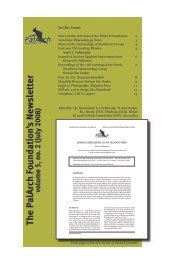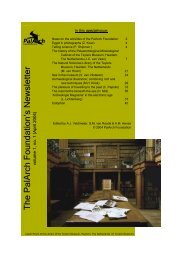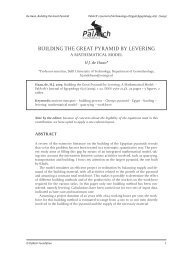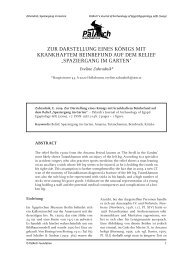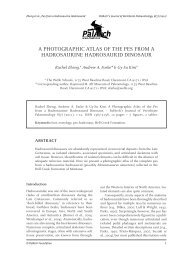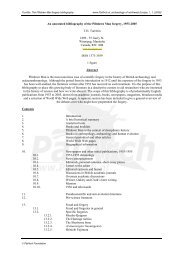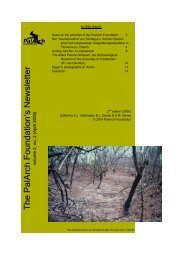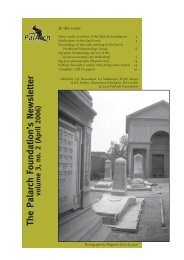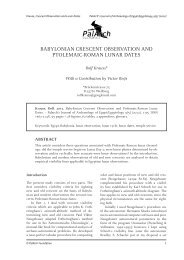neural spine bifurcation in sauropod dinosaurs of the - PalArch
neural spine bifurcation in sauropod dinosaurs of the - PalArch
neural spine bifurcation in sauropod dinosaurs of the - PalArch
You also want an ePaper? Increase the reach of your titles
YUMPU automatically turns print PDFs into web optimized ePapers that Google loves.
Wedel & Taylor, Neural Sp<strong>in</strong>e Bifurcation <strong>in</strong> Sauropods <strong>PalArch</strong>’s Journal <strong>of</strong> Vertebrate Palaeontology, 10(1) (2013)<br />
ogy <strong>of</strong> an anterior cervical vertebra <strong>in</strong> an adult,<br />
and it compares especially well to C4 and C5<br />
<strong>of</strong> D. carnegii CM 84/94. The apparent centrum<br />
length (measured from <strong>the</strong> scale bar <strong>in</strong><br />
<strong>the</strong> figure) <strong>of</strong> MOR 790 8-10-96-204 is 28 cm,<br />
compared to 29 cm and 37 cm for C4 and C5<br />
<strong>of</strong> D. carnegii CM 84/94, respectively. So MOR<br />
790 8-10-96-204 is roughly <strong>the</strong> same size as <strong>the</strong><br />
adult C4 and about 80% <strong>of</strong> <strong>the</strong> size <strong>of</strong> <strong>the</strong> adult<br />
C5. Fur<strong>the</strong>rmore, its <strong>neural</strong> arch appears to be<br />
fused and its cervical ribs are fused to <strong>the</strong> <strong>neural</strong><br />
arch and centrum, whereas <strong>the</strong> cervical ribs<br />
<strong>of</strong> <strong>the</strong> ‘adult’ D. carnegii CM 84/94 are not yet<br />
fused <strong>in</strong> C2-C5.<br />
In sum, <strong>the</strong> isolated MOR vertebra shown<br />
<strong>in</strong> Woodruff & Fowler (2012: figure 2) is most<br />
likely a C4 or C5 <strong>of</strong> an adult Diplodocus similar<br />
<strong>in</strong> size to D. carnegii CM 84/94, and based on<br />
cervical rib fusion it may be from an <strong>in</strong>dividual<br />
that is actually more mature than CM 84/94. All<br />
<strong>of</strong> <strong>the</strong> differences between that vertebra and<br />
<strong>the</strong> D. carnegii C12 shown <strong>in</strong> <strong>the</strong> same figure<br />
are more easily expla<strong>in</strong>ed as consequences <strong>of</strong><br />
serial, ra<strong>the</strong>r than ontogenetic, variation. The<br />
implications <strong>of</strong> this apparently adult vertebra<br />
be<strong>in</strong>g found <strong>in</strong> <strong>the</strong> Mo<strong>the</strong>r’s Day Quarry are explored<br />
below <strong>in</strong> <strong>the</strong> Discussion.<br />
Ontogenetic series <strong>of</strong> Woodruff & Fowler<br />
(2012) reassessed<br />
In <strong>the</strong> Materials and Methods, Woodruff &<br />
Fowler (2012: 2) stated: “Study specimens comprise<br />
38 cervical, eight dorsal, and two caudal<br />
vertebrae from 18 immature and one adult diplodocid<br />
(Diplodocus sp., Apatosaurus sp., and<br />
Barosaurus sp.), and two immature macronarians<br />
(both Camarasaurus sp.).”<br />
However, <strong>the</strong>ir Table 1 and Supplementary Information<br />
list only 15 specimens, not 18. Of <strong>the</strong><br />
15, one is probably not a diplodocid (SMA 0009<br />
‘Baby Toni’; Woodruff & Fowler (2012: Supplementary<br />
Information, pp. 5-6). Of <strong>the</strong> rema<strong>in</strong><strong>in</strong>g<br />
14 specimens, 11 are isolated vertebrae, so only<br />
three represent reasonably complete probablydiplodocoid<br />
series (MOR 592, AMNH 7535, and<br />
CM 555). From Apatosaurus CM 555 <strong>the</strong>y discuss<br />
only one vertebra, <strong>the</strong> sixth cervical. AMNH<br />
7535 is not mentioned at all outside <strong>of</strong> Table 1<br />
and a pass<strong>in</strong>g mention <strong>the</strong> Supplementary Information,<br />
so <strong>the</strong> subadult diplodocid data actually<br />
used <strong>in</strong> <strong>the</strong> paper consist <strong>of</strong> isolated vertebrae<br />
and only a s<strong>in</strong>gle articulated series, MOR 592.<br />
The aff<strong>in</strong>ities <strong>of</strong> MOR 592 are uncerta<strong>in</strong>.<br />
Wilson & Smith (1996) provisionally referred<br />
it to Amphicoelias. Whitlock (2011: 890, table 8)<br />
provisionally referred it to Dicraeosauridae,<br />
writ<strong>in</strong>g: “A partial bra<strong>in</strong>case, skull ro<strong>of</strong>, and<br />
dentary (MOR 592), previously referred to<br />
<strong>the</strong> basal diplodocoid Amphicoelias (Wilson &<br />
Smith, 1996), appear to belong <strong>in</strong>stead to a dicraeosaurid.<br />
A sharp crest on <strong>the</strong> supraoccipital<br />
(character 45) and <strong>the</strong> presence <strong>of</strong> a tuberosity<br />
near <strong>the</strong> dentary symphysis (character 61) both<br />
suggest dicraeosaurid aff<strong>in</strong>ities, although <strong>the</strong><br />
dentary symphysis is <strong>in</strong>termediate between <strong>the</strong><br />
subtriangular dicraeosaurid and <strong>the</strong> ovate diplodocid<br />
conditions. This and o<strong>the</strong>r m<strong>in</strong>or differences<br />
between <strong>the</strong>se elements and Suuwassea<br />
emilieae (Harris, 2006a) preclude referral <strong>of</strong><br />
MOR 592 to that taxon, but it is probable that<br />
<strong>the</strong> two are closely related.”<br />
Woodruff & Fowler (2012: table 1) referred<br />
MOR 592 to Diplodoc<strong>in</strong>ae, imply<strong>in</strong>g that it is<br />
more closely related to Diplodocus and Barosaurus<br />
than to Apatosaurus or <strong>the</strong> dicraeosaurids.<br />
However, <strong>the</strong>y provided no rationale for this<br />
referral, and did not discuss <strong>the</strong> dicraeosaurid<br />
referral <strong>of</strong> Whitlock (2011), although <strong>the</strong>y cited<br />
that paper. At present, <strong>the</strong> hypo<strong>the</strong>sis <strong>of</strong> Whitlock<br />
(2011) that MOR 592 represents a dicraeosaurid<br />
has not been falsified. Therefore <strong>the</strong> data<br />
used by Woodruff & Fowler (2012) do not <strong>in</strong>clude<br />
any articulated subadult diplodocids (i.e.<br />
from CM 555 <strong>the</strong>y used only one vertebra, and<br />
MOR 592 is probably not a diplodocid).<br />
Woodruff & Fowler (2012) did not state what<br />
criteria <strong>the</strong>y used to <strong>in</strong>fer age <strong>in</strong> <strong>the</strong>ir specimens.<br />
Neural arch fusion is discussed <strong>in</strong> general terms<br />
<strong>in</strong> <strong>the</strong> Supplementary Information, but <strong>in</strong> <strong>the</strong><br />
text and <strong>in</strong> <strong>the</strong> figures specimens are ordered<br />
and discussed simply <strong>in</strong> terms <strong>of</strong> size. This is<br />
problematic because size is a notoriously unreliable<br />
criterion <strong>of</strong> age; MOR 790 8-10-96-204<br />
from figure 2 <strong>in</strong> Woodruff & Fowler (2012) also<br />
appears <strong>in</strong> <strong>the</strong>ir figure 3 as <strong>the</strong> second-smallest<br />
vertebra <strong>in</strong> this ‘ontogenetic’ series, despite<br />
most likely com<strong>in</strong>g from a well-fused adult approximately<br />
<strong>the</strong> same size as <strong>the</strong> D. carnegii <strong>in</strong>dividual<br />
that represents <strong>the</strong> end <strong>of</strong> <strong>the</strong> series.<br />
So without any evidence o<strong>the</strong>r than sheer size<br />
(if that size overlaps with <strong>the</strong> adult size range)<br />
and degree <strong>of</strong> <strong>neural</strong> <strong>sp<strong>in</strong>e</strong> <strong>bifurcation</strong> (which<br />
cannot help but overlap with <strong>the</strong> adult range,<br />
s<strong>in</strong>ce <strong>the</strong> adult range encompasses all possible<br />
states), simply pick<strong>in</strong>g small vertebrae with un-<br />
© <strong>PalArch</strong> Foundation 16



